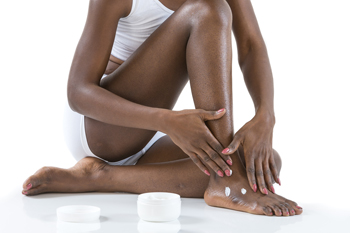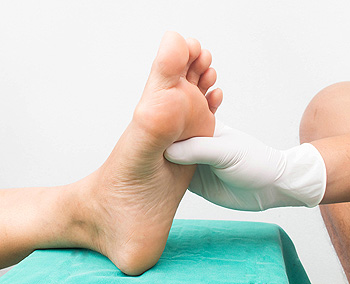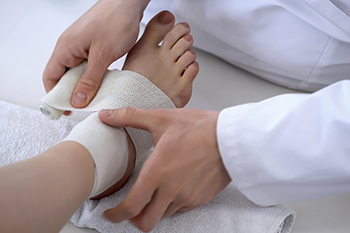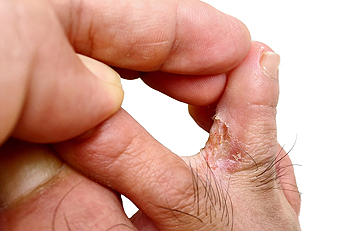Connect With Us
Blog
Items filtered by date: July 2022
How to Prevent Injuries to Your Feet

Many foot problems affect the bones and inner workings of the feet, but it is also important to protect the skin and soft tissues of your feet from injury. Studies show that problems with the skin and fat pads in the feet are common in around 80 percent of adults. It is important to protect skin in three areas: the outer layer of the skin from chafing and irritation, the underlying layers from undue pressure and force, and the fat pads of the heel, the ball of the foot, and the bottom of the toes. After the age of 30, the fat pads of the foot start to break down offering less protection from pounding and stress. This adds to the soreness of the feet at the end of the day. By age 50, the skin of the foot also becomes thin. This leaves your feet more vulnerable to blisters, cuts, bruises, and other types of skin damage. It is suggested that you check your feet each day for any lesions or unusual sores. Keep your feet clean and moisturized daily. Make sure toenails are cut straight across to avoid ingrown toenails. Wear moisture-wicking padded socks and avoid walking around barefoot. Wear shoes that fit properly and alternate pairs of shoes every day. If you are experiencing foot pain regularly but are unsure of the cause, please see a chiropodist for an exam and treatment options.
Caring for your feet is not just something done at the chiropodist’s office. Good foot care starts at home. If you would like to learn more about daily foot care practices, please consult with one of our chiropodists from West Toronto Foot & Ankle Clinic Inc. . Our chiropodist can help you maintain the health of your lower limbs and your mobility.
There are many things that you can do at home to help care for your feet, including:
- Wearing shoes and socks that fit properly
- Washing the feet daily with soap and water
- Drying the feet thoroughly
- Applying moisturizer to the soles and heels of the feet
- Taking a walk and exercising the feet regularly
- Doing foot stretches and strengthening exercises
A chiropodist can help figure out a manageable foot care routine for you to keep your feet healthy. If you have any questions, please feel free to contact our office located in . We offer the newest diagnostic and treatment technologies for all your foot care needs.
Causes and Symptoms of Diabetic Neuropathy

Diabetic neuropathy is a condition that appears in about half of all diabetic patients. It develops gradually, as a result of having uncontrolled high levels of blood sugar for long periods and is common in both type 1 and type 2 diabetes. Peripheral neuropathy occurs when the nerves that supply the extremities are damaged, commonly affecting the lower legs and the feet. Symptoms of diabetic neuropathy include numbness, dizziness when standing, sweating, muscle weakness, and difficulty with balance. Among the causes are damage to blood vessels, high blood pressure, excessive alcohol use, smoking, and side effects from certain medications. Because of numbness and an inability to detect extremes in temperature, the feet can be seriously affected by neuropathy. Sores and cuts can turn into ulcers if not attended to in a timely fashion. Ulcers on the legs and feet can turn into gangrene, if ignored. Neuropathy is not reversible, but it can be managed with the proper care. If you have diabetes, it is highly suggested that you seek the regular care of a chiropodist to monitor your condition and offer treatment solutions as potential problems arise.
Neuropathy can cause permanent nerve damage if left untreated. If you are experiencing the symptoms of peripheral neuropathy, please consult with one of our chiropodists from West Toronto Foot & Ankle Clinic Inc. . Our chiropodist will assess your condition and provide you with quality foot and ankle treatment.
What Is Peripheral Neuropathy?
Peripheral neuropathy is a condition that damages the nerves of the peripheral nervous system, which provide sensation to the limbs. The feet are often affected. Peripheral neuropathy can have many different causes, but it is most commonly associated with diabetes.
Symptoms
Common symptoms of peripheral neuropathy include:
- Pain
- Numbness or tingling sensation
- Burning sensations
- Weakness
- Loss of balance
Diagnosis
Peripheral neuropathy is diagnosed based on medical history and physical examination. Various tests performed during physical examinations can help determine the type of peripheral neuropathy you may have and what is causing it.
Treatment
Treatment for peripheral neuropathy will depend on what is causing it. For example, if your peripheral neuropathy is caused by diabetes, then managing your blood sugar, exercising regularly to strengthen the legs and feet, and taking pain medications may be recommended as treatments.
If you have any questions, please feel free to contact our office located in . We offer the newest diagnostic and treatment technologies for all your foot care needs.
Reminder: When Was the Last Time...?
Three Grades of Ankle Sprains

A simple misstep can result in a sprained ankle. It happens when the ligaments stretch beyond their normal limits. It is a common injury, and can happen to people from all walks of life. The symptoms that are generally associated with this type of injury include immediate swelling, and bruising, and it can be difficult to walk. Prompt treatment is often necessary to ensure the ankle heals correctly, and it is important to maintain mobility and full range of motion. A lateral ankle sprain happens when the foot rolls inward, and the ligaments are damaged on the outer ankle. There are three grades of ankle sprains that can occur. When the ankle is overstretched slightly, a grade one sprain has occurred. It is often possible to walk with this type of sprain. The symptoms of a grade two sprain include moderate pain, tenderness, and the ankle can be swollen. Walking can be painful, and there is often a loss of range of motion. A grade three sprain consists of a full rupture, and it is impossible to walk. If you have sprained your ankle, please visit a chiropodist as quickly as possible who can determine what the best treatment is for your grade of ankle sprain.
When one or more ligaments in the ankle overstretch or tear due to injury, an ankle sprain occurs. If you would like to learn more about ankle sprains, please consult with one of our chiropodists from West Toronto Foot & Ankle Clinic Inc. . Our chiropodist can help you maintain the health of your lower limbs and your mobility.
Symptoms of an ankle sprain vary depending on the severity of the injury, but may include:
- Pain
- Swelling
- Bruising
- Tenderness
- Difficulty walking
- Ankle instability
- A reduced range of motion in the ankle
Treatments for an ankle sprain may consist of:
- Resting the injured ankle
- Applying ice
- Elevating the ankle
- Compressing the ankle
- Over-the-counter pain medications
- Ankle braces or other devices to take weight off of the ankle
- Ankle exercises
- Surgery (in rare cases)
It’s important for the sprained ankle to heal correctly and fully in order to avoid repeated injury. If you have any questions, please feel free to contact our office located in . We offer the newest diagnostic and treatment technologies for all your foot care needs.
Why Is Athlete’s Foot Called Athlete’s Foot?

Athlete’s foot got its name because athletes sweat a lot and can develop the foot fungus called Tinea Pedis. However, anyone whose feet are subject to warm, wet conditions can get athlete’s foot. This fungus grows under and between the toes. The skin can crack, flake, itch, or burn, and it can be painful to walk. Those who walk barefoot around pools, in locker rooms, or in public showers are more prone to athlete’s foot. It is important to keep the feet clean and dry. The shoes worn should permit air to circulate so moisture does not become trapped. Socks should be made of fibers that absorb perspiration. Fungus-killing powders, creams, or lotions may be applied to feet after showers. If you suffer from this condition or need help preventing recurrences, see a chiropodist who can treat your feet and restore them to health.
Athlete’s foot can be uncomfortable and unsightly. To learn more about preventing and treating this condition, please consult with one of our chiropodists from West Toronto Foot & Ankle Clinic Inc. . Our chiropodist will assess your condition and provide you with quality foot and ankle treatment.
What Is Athlete’s Foot?
Athlete’s foot refers to an infection of the skin on the feet that is caused by a fungus. This fungus is contagious and thrives in warm and moist environments. It is often spread in common areas such as public pools, locker rooms, and showers. It can also spread when sharing personal items, like shoes or towels, with an infected person.
Symptoms
The symptoms of athlete’s foot may include:
- Itching, stinging, or burning of the skin on the feet
- Cracking or peeling skin, especially between the toes and on the soles of the feet
- Scaly, red rash on the foot
- Blisters
- Foul odor
Treatment
Treatment for athlete’s foot typically involves using over-the-counter topical antifungal medications on the feet. When over-the-counter options are ineffective, you may need to take prescription oral medications or topical antifungal drugs, or a combination of both.
Prevention
Preventing athlete’s foot places an emphasis on good foot hygiene practices.
You can prevent athlete’s foot by:
- Washing and drying your feet thoroughly every day
- Wearing shoes when walking in public areas
- Not sharing personal items, like shoes or socks, with others
- Wearing shoes and socks made out of breathable materials
If you have any questions, please feel free to contact our office located in . We offer the newest diagnostic and treatment technologies for all your foot care needs.
Blog Archives
- November 2025
- October 2025
- September 2025
- August 2025
- July 2025
- June 2025
- May 2025
- April 2025
- March 2025
- February 2025
- January 2025
- December 2024
- November 2024
- October 2024
- September 2024
- August 2024
- July 2024
- June 2024
- May 2024
- April 2024
- March 2024
- February 2024
- January 2024
- December 2023
- November 2023
- October 2023
- September 2023
- August 2023
- July 2023
- June 2023
- May 2023
- April 2023
- March 2023
- February 2023
- January 2023
- December 2022
- November 2022
- October 2022
- September 2022
- August 2022
- July 2022
- June 2022
- May 2022
- April 2022
- March 2022
- February 2022
- January 2022
- December 2021
- November 2021
- October 2021
- September 2021
- August 2021
- July 2021
- June 2021
- May 2021
- April 2021
- February 2021
- January 2021

